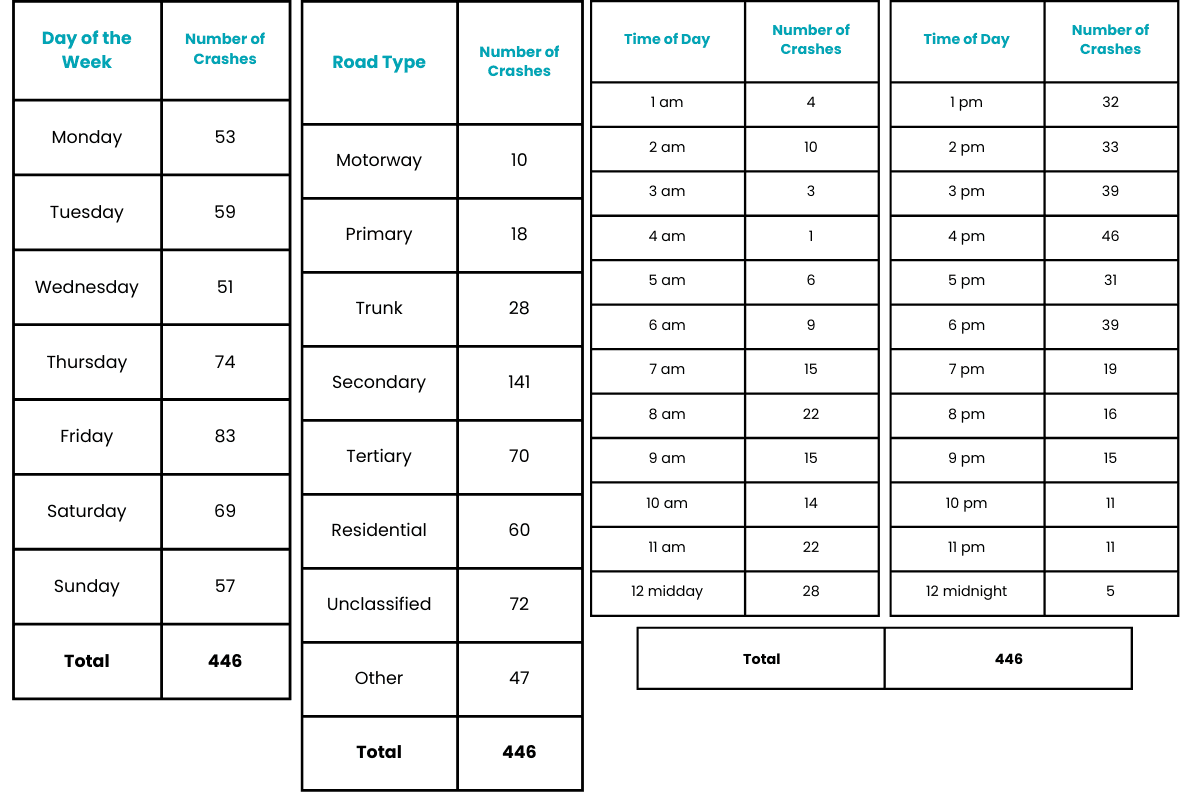Irish Road Safety Week 2024
Irish Road Safety Week 2024
Oct 7, 2024

Ahead of Irish Road Safety Week taking place next week, October 7-13,we reveal data from 446 crash incidents among its black box policy-holders over a 20-month period (Jan 3 2023 to Sept 3 2024).
Following on the findings, we are again calling for the mandatory fitting of black boxes on the vehicles of all new and first-time drivers for their first two years on the road to encourage safer driving, and reduce collisions, injuries and fatalities among younger drivers in particular.
When it comes to the day of the week most likely to record a crash, Friday came out on top with 83 crash incidents, followed by Thursdays (74) and Saturdays (69).
Afternoons, and rush-hour in particular, were the most dangerous times of the day in terms of the possibility of a crash, with 4-5pm the most risky time (46 incidents). There was a total of 155 crash reports between 3 and 7pm. Early morning had the least number of crashes.
Secondary roads were by far the most dangerous location for crashes with 141 incidents reported. This was approximately double the next road classification, with 70 incidents recorded on tertiary roads, and 72 on unclassified roads. Perhaps, unsurprisingly, motorways reported the least number of crashes at just 10.
Record Deaths
The data was recorded using black box intelligence or telematics devices. Telematics uses GPS and other technology to send information about the way a vehicle is being driven, including speed limit of the road, road type and road surface. It rewards people who drive safely by monitoring the big five risk factors: speeding, driving smoothness (braking, acceleration and cornering), distance travelled, where travelling to, and when travelling. Sister company, Axon Telematics, has developed the innovative telematics technology used by MCL Insurance across its policies.
Last year, according to the Road Safety Authority (RSA), a total of 1881 people died on our roads, the highest number since 2014. As of the end of September, figures from An Garda Síochána show that the number has already reached 1362 for this year.
Black Boxes Save Lives
Commenting on the findings, Gary McClarty, director of MCL Insurance Services (Ireland) Limited, said:
“It’s clear that Fridays, and weekends in general, evening rush hour, and secondary roads, are key factors when it comes to the incidence of road crashes among our policy-holders using black box devices. This would suggest that the risk of having a crash increases with higher traffic volumes in the evenings, when people are travelling home from work, or at weekends when more people are on the move travelling to events or going on trips. It is not surprising that motorways have the least number of crashes and secondary roads the most. Secondary roads are for the most part single carriageway, have more stops and intersections, can often be narrow and winding, and are sometimes poorly maintained, increasing the risk of a crash.

“We know that, according to the RSA, of the 188 people who died on our roads last year, 78% were male, and that a quarter (26%)3 were 16-25 years, despite comprising only 12%4 of the population. We know that younger drivers have the highest number of accidents, however, there is a way to encourage safer driving. Black boxes save lives and that’s why we’re calling on Government to mandate all young and first-time drivers to have these devices fitted to their vehicles for their first two years on the road, a cost which I believe insurance providers will readily absorb as it will also bring down the high cost of claims. Not only would the technology lead to reduced injury and death on our roads, but reduced premiums too.”
A full breakdown of Black Box Data below:

Ahead of Irish Road Safety Week taking place next week, October 7-13,we reveal data from 446 crash incidents among its black box policy-holders over a 20-month period (Jan 3 2023 to Sept 3 2024).
Following on the findings, we are again calling for the mandatory fitting of black boxes on the vehicles of all new and first-time drivers for their first two years on the road to encourage safer driving, and reduce collisions, injuries and fatalities among younger drivers in particular.
When it comes to the day of the week most likely to record a crash, Friday came out on top with 83 crash incidents, followed by Thursdays (74) and Saturdays (69).
Afternoons, and rush-hour in particular, were the most dangerous times of the day in terms of the possibility of a crash, with 4-5pm the most risky time (46 incidents). There was a total of 155 crash reports between 3 and 7pm. Early morning had the least number of crashes.
Secondary roads were by far the most dangerous location for crashes with 141 incidents reported. This was approximately double the next road classification, with 70 incidents recorded on tertiary roads, and 72 on unclassified roads. Perhaps, unsurprisingly, motorways reported the least number of crashes at just 10.
Record Deaths
The data was recorded using black box intelligence or telematics devices. Telematics uses GPS and other technology to send information about the way a vehicle is being driven, including speed limit of the road, road type and road surface. It rewards people who drive safely by monitoring the big five risk factors: speeding, driving smoothness (braking, acceleration and cornering), distance travelled, where travelling to, and when travelling. Sister company, Axon Telematics, has developed the innovative telematics technology used by MCL Insurance across its policies.
Last year, according to the Road Safety Authority (RSA), a total of 1881 people died on our roads, the highest number since 2014. As of the end of September, figures from An Garda Síochána show that the number has already reached 1362 for this year.
Black Boxes Save Lives
Commenting on the findings, Gary McClarty, director of MCL Insurance Services (Ireland) Limited, said:
“It’s clear that Fridays, and weekends in general, evening rush hour, and secondary roads, are key factors when it comes to the incidence of road crashes among our policy-holders using black box devices. This would suggest that the risk of having a crash increases with higher traffic volumes in the evenings, when people are travelling home from work, or at weekends when more people are on the move travelling to events or going on trips. It is not surprising that motorways have the least number of crashes and secondary roads the most. Secondary roads are for the most part single carriageway, have more stops and intersections, can often be narrow and winding, and are sometimes poorly maintained, increasing the risk of a crash.

“We know that, according to the RSA, of the 188 people who died on our roads last year, 78% were male, and that a quarter (26%)3 were 16-25 years, despite comprising only 12%4 of the population. We know that younger drivers have the highest number of accidents, however, there is a way to encourage safer driving. Black boxes save lives and that’s why we’re calling on Government to mandate all young and first-time drivers to have these devices fitted to their vehicles for their first two years on the road, a cost which I believe insurance providers will readily absorb as it will also bring down the high cost of claims. Not only would the technology lead to reduced injury and death on our roads, but reduced premiums too.”
A full breakdown of Black Box Data below:

Ahead of Irish Road Safety Week taking place next week, October 7-13,we reveal data from 446 crash incidents among its black box policy-holders over a 20-month period (Jan 3 2023 to Sept 3 2024).
Following on the findings, we are again calling for the mandatory fitting of black boxes on the vehicles of all new and first-time drivers for their first two years on the road to encourage safer driving, and reduce collisions, injuries and fatalities among younger drivers in particular.
When it comes to the day of the week most likely to record a crash, Friday came out on top with 83 crash incidents, followed by Thursdays (74) and Saturdays (69).
Afternoons, and rush-hour in particular, were the most dangerous times of the day in terms of the possibility of a crash, with 4-5pm the most risky time (46 incidents). There was a total of 155 crash reports between 3 and 7pm. Early morning had the least number of crashes.
Secondary roads were by far the most dangerous location for crashes with 141 incidents reported. This was approximately double the next road classification, with 70 incidents recorded on tertiary roads, and 72 on unclassified roads. Perhaps, unsurprisingly, motorways reported the least number of crashes at just 10.
Record Deaths
The data was recorded using black box intelligence or telematics devices. Telematics uses GPS and other technology to send information about the way a vehicle is being driven, including speed limit of the road, road type and road surface. It rewards people who drive safely by monitoring the big five risk factors: speeding, driving smoothness (braking, acceleration and cornering), distance travelled, where travelling to, and when travelling. Sister company, Axon Telematics, has developed the innovative telematics technology used by MCL Insurance across its policies.
Last year, according to the Road Safety Authority (RSA), a total of 1881 people died on our roads, the highest number since 2014. As of the end of September, figures from An Garda Síochána show that the number has already reached 1362 for this year.
Black Boxes Save Lives
Commenting on the findings, Gary McClarty, director of MCL Insurance Services (Ireland) Limited, said:
“It’s clear that Fridays, and weekends in general, evening rush hour, and secondary roads, are key factors when it comes to the incidence of road crashes among our policy-holders using black box devices. This would suggest that the risk of having a crash increases with higher traffic volumes in the evenings, when people are travelling home from work, or at weekends when more people are on the move travelling to events or going on trips. It is not surprising that motorways have the least number of crashes and secondary roads the most. Secondary roads are for the most part single carriageway, have more stops and intersections, can often be narrow and winding, and are sometimes poorly maintained, increasing the risk of a crash.

“We know that, according to the RSA, of the 188 people who died on our roads last year, 78% were male, and that a quarter (26%)3 were 16-25 years, despite comprising only 12%4 of the population. We know that younger drivers have the highest number of accidents, however, there is a way to encourage safer driving. Black boxes save lives and that’s why we’re calling on Government to mandate all young and first-time drivers to have these devices fitted to their vehicles for their first two years on the road, a cost which I believe insurance providers will readily absorb as it will also bring down the high cost of claims. Not only would the technology lead to reduced injury and death on our roads, but reduced premiums too.”
A full breakdown of Black Box Data below:
